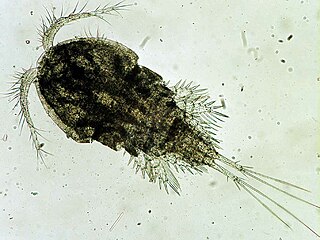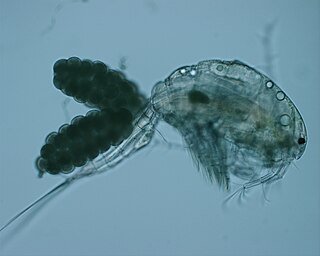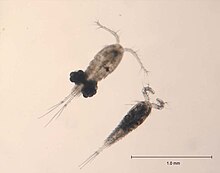
The Cyclopoida are an order of small crustaceans from the subclass Copepoda. Like many other copepods, members of Cyclopoida are small, planktonic animals living both in the sea and in freshwater habitats. They are capable of rapid movement. Their larval development is metamorphic, and the embryos are carried in paired or single sacs attached to first abdominal somite.

Cyclops is one of the most common genera of freshwater copepods, comprising over 400 species. Together with other similar-sized non-copepod fresh-water crustaceans, especially cladocera, they are commonly called water fleas. The name Cyclops comes from the Cyclops of Greek mythology, as they have a single large eye; in Cyclops, the eye may be either red or black.
Acanthocyclops is a genus of copepod crustaceans in the family Cyclopidae. It was originally described by Friedrich Kiefer as a subgenus of Cyclops, and contains the following species:
Afrocyclops is a genus of copepod crustaceans in the family Cyclopidae, containing the following species:
Elaphoidella is a genus of freshwater copepods in the family Canthocamptidae. It contains over 200 species, including three classified as vulnerable species by the IUCN – three endemic to Slovenia and one endemic to the United States. In total, the genus Elaphoidella contains the following species:

Mesocyclops is a genus of copepod crustaceans in the family Cyclopidae. Because the various species of Mesocyclops are known to prey on mosquito larvae, it is used as a nontoxic and inexpensive form of biological mosquito control.
Metacyclops is a genus of copepod crustaceans in the family Cyclopidae, containing 61 species, of which three are listed on the IUCN Red List – M. campestris from Brazil, M. gasparoi from Italy (vulnerable) and M. postojnae from Slovenia (vulnerable).
Muscocyclops is a genus of copepod crustaceans in the family Cyclopidae, comprising three species found only in South America. Two of the species – Muscocyclops bidentatus Reid, 1987 and Muscocyclops therasiae Reid, 1987 – are endemic to the Distrito Federal in Brazil, and are listed as conservation dependent on the IUCN Red List. The third species is Muscocyclops operculatus.
Speleoithona is a genus of copepods in the family Speleoithonidae, containing the following species:

Thermocyclops is a genus of crustacean in family Cyclopidae. It was first described and later extensively researched by Friedrich Kiefer, who discovered some 20 species. The species and subspecies of the genus inhabit fresh and brackish waters alike all around the world, although most are from tropical areas.
Tropocyclops is a genus of copepod crustaceans in the family Cyclopidae. It contains the following species:

Canthocamptidae is a family of copepods. Most of the 700 species are confined to fresh water, although there are also marine species. It contains the following genera:
Megacyclops is a genus of copepods, containing the following species:

Cyclops bicuspidatus is a planktonic species of copepod found throughout the world, except Australia, and characteristic of the Great Lakes of North America. It is a deep water species found throughout the year with peak abundance occurring in May or June. Males grow up to 0.8–1.0 millimetre (0.031–0.039 in) long, while females are larger at 0.9–1.6 mm (0.035–0.063 in).
Halicyclops is a genus of copepods belonging to the family Cyclopidae. There are currently 94 described species found in brackish habitats throughout the world:

The clade Multicrustacea constitutes the largest superclass of crustaceans, containing approximately four-fifths of all described crustacean species, including crabs, lobsters, crayfish, shrimp, krill, prawns, woodlice, barnacles, copepods, amphipods, mantis shrimp and others. The largest branch of multicrustacea is the class Malacostraca.
Microcyclops is a genus of copepods, containing the following species:
Oithona is a planktonic crustacean genus found in marine, brackish, fresh water environments. Oithona has been described as the most ubiquitous and abundant copepod in the world's oceans. It was first described by Baird in 1843 using the species Oithona plumifera as taxon type.

Bryocyclops is a genus of freshwater-dwelling cyclopoid copepods. The epithet Bryo- for Bryophyta (Mosses) refers to the fact that the first few species were described from mosses.







